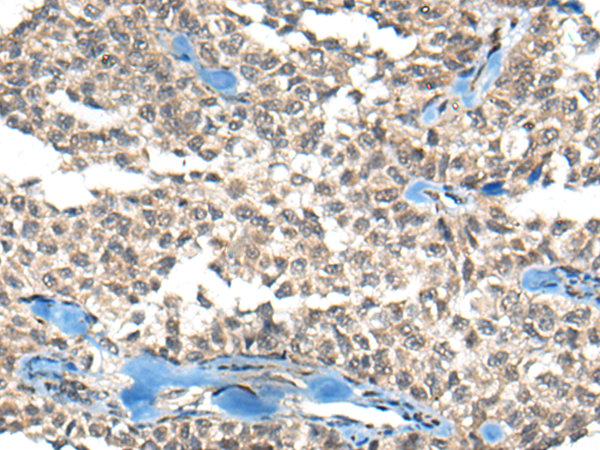
| WB | 咨询技术 | Human,Mouse,Rat |
| IF | 咨询技术 | Human,Mouse,Rat |
| IHC | 1/30-1/150 | Human,Mouse,Rat |
| ICC | 技术咨询 | Human,Mouse,Rat |
| FCM | 咨询技术 | Human,Mouse,Rat |
| Elisa | 1/5000-1/10000 | Human,Mouse,Rat |
| Aliases | WT6; XBR; NRSF |
| Host/Isotype | Rabbit IgG |
| Antibody Type | Primary antibody |
| Storage | Store at 4°C short term. Aliquot and store at -20°C long term. Avoid freeze/thaw cycles. |
| Species Reactivity | Human |
| Immunogen | Synthetic peptide of human REST |
| Formulation | Purified antibody in PBS with 0.05% sodium azide and 50% glycerol. |
+ +
以下是关于REST抗体的3篇参考文献及其简要摘要:
1. **文献名称**:*REST: A mammalian silencer protein that restricts sodium channel gene expression to neurons*
**作者**:Schoenherr, C.J., Anderson, D.J.
**摘要**:该研究首次克隆并鉴定了REST(NRSF)蛋白,证明其通过结合神经元基因的保守沉默元件(NRSE),抑制钠离子通道等神经元特异性基因在非神经元细胞中的表达,揭示了REST在细胞类型特异性基因调控中的关键作用。
2. **文献名称**:*Regulation of neuronal traits by a novel transcriptional complex containing REST*
**作者**:Ballas, N., Grunseich, C., Lu, D.D., et al.
**摘要**:本文发现REST通过招募组蛋白去乙酰化酶(HDAC)和甲基转移酶等染色质修饰复合物,形成多蛋白抑制复合物,从而在表观遗传层面调控神经分化相关基因的沉默,为REST在神经发育和疾病中的机制提供了新见解。
3. **文献名称**:*Antibody-based profiling of REST expression in glioblastoma multiforme*
**作者**:Conti, A., Aguennouz, M., La Torre, D., et al.
**摘要**:该研究利用特异性REST抗体,通过免疫组化分析胶质母细胞瘤(GBM)组织样本,发现REST的高表达与肿瘤恶性程度及患者预后不良显著相关,提示其可作为潜在诊断标志物或治疗靶点。
4. **文献名称**:*Phosphorylation of REST regulates its nuclear translocation and transcriptional activity*
**作者**:Otto, S.J., McCorkle, S.R., Hover, J., et al.
**摘要**:本文揭示了REST的磷酸化修饰(如Ser861位点)通过调控其亚细胞定位(胞质滞留或核转位),动态影响其对靶基因的抑制作用,为理解REST在神经分化或肿瘤中的动态调控机制提供了新视角。
以上文献涵盖REST的基础功能、表观调控机制、抗体应用及翻译后修饰研究,均发表于高影响力期刊(如*Cell*、*Nature Neuroscience*等),为相关领域的重要参考。
REST (RE1-Silencing Transcription Factor), also known as NRSF (Neuron-Restrictive Silencing Factor), is a transcriptional repressor critical for regulating neuron-specific genes in non-neuronal cells and neural progenitors. It binds to RE1 (Repressor Element 1) sequences, recruiting chromatin-modifying complexes to suppress neuronal differentiation genes, thereby maintaining cellular pluripotency or directing cell fate decisions. Dysregulation of REST is implicated in neurological disorders, cancers, and developmental defects. For instance, aberrant REST activity is observed in brain tumors, neurodevelopmental disorders, and neurodegenerative diseases like Alzheimer’s.
REST antibodies are essential tools for studying its expression, localization, and function. They enable detection via techniques like Western blot, immunohistochemistry, and ChIP-seq, helping researchers explore REST’s role in gene silencing, neural development, and disease mechanisms. Commercial REST antibodies are often validated for specificity against conserved epitopes, though isoforms and post-translational modifications (e.g., phosphorylation) can complicate detection. Studies using these antibodies have revealed REST’s dual roles in cancer—acting as a tumor suppressor in some contexts (e.g., medulloblastoma) and an oncogene in others (e.g., glioblastoma). Additionally, REST antibodies aid in investigating its interplay with non-coding RNAs and epigenetic regulators, advancing insights into neuroplasticity and therapeutic targeting.
×